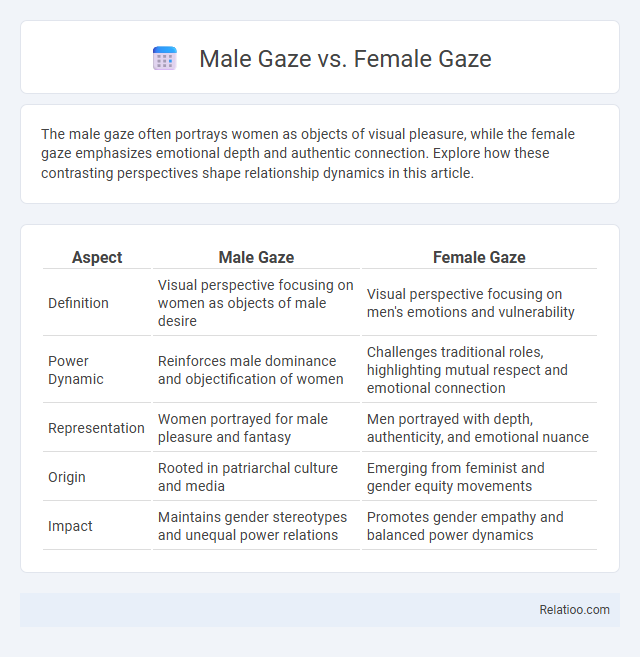The male gaze often portrays women as objects of visual pleasure, while the female gaze emphasizes emotional depth and authentic connection. Explore how these contrasting perspectives shape relationship dynamics in this article.
Table of Comparison
| Aspect | Male Gaze | Female Gaze |
|---|---|---|
| Definition | Visual perspective focusing on women as objects of male desire | Visual perspective focusing on men's emotions and vulnerability |
| Power Dynamic | Reinforces male dominance and objectification of women | Challenges traditional roles, highlighting mutual respect and emotional connection |
| Representation | Women portrayed for male pleasure and fantasy | Men portrayed with depth, authenticity, and emotional nuance |
| Origin | Rooted in patriarchal culture and media | Emerging from feminist and gender equity movements |
| Impact | Maintains gender stereotypes and unequal power relations | Promotes gender empathy and balanced power dynamics |
Understanding the Concept of the Male Gaze
The concept of the Male Gaze, introduced by film theorist Laura Mulvey, describes how visual media often presents women as objects for male pleasure, reinforcing power imbalances. Your awareness of the Male Gaze helps in recognizing how female characters are frequently depicted through a lens prioritizing male desire, while the Female Gaze offers a perspective that centers women's experiences and agency. Understanding these distinctions is crucial to challenging objectification and promoting more balanced and authentic portrayals in media.
Exploring the Origins of the Female Gaze
The female gaze originated as a counter-narrative to the dominant male gaze, challenging traditional representations that often objectify women in visual media. Rooted in feminist film theory, the female gaze emphasizes empathy, subjectivity, and the complexity of female experience rather than reducing women to mere objects of desire. This shift seeks to transform how female characters are portrayed by prioritizing their agency and inner lives instead of passive visual consumption.
Key Differences Between Male Gaze and Female Gaze
The male gaze typically represents a visual perspective that objectifies women by portraying them as passive subjects for male pleasure, often emphasizing physical appearance and sexualization. In contrast, the female gaze offers a more empathetic and nuanced portrayal, focusing on women's experiences and agency, highlighting emotional depth and individuality rather than mere physicality. Unlike objectification rooted in the male gaze, the female gaze seeks to subvert these power dynamics by promoting respect, complexity, and subjectivity in representation.
Impact of the Male Gaze in Cinema and Media
The male gaze in cinema and media often frames women as objects for male pleasure, influencing how stories are told and characters are portrayed, which can perpetuate gender stereotypes and contribute to female objectification. This perspective shapes Your perception by reinforcing unrealistic beauty standards and limiting the representation of female agency and complexity on screen. Challenging the male gaze requires conscious efforts to include diverse female viewpoints and narratives, fostering a more balanced and authentic media landscape.
Female Gaze: Redefining Representation and Perspective
The female gaze challenges traditional visual narratives by prioritizing authentic emotional experiences and multidimensional characters, shifting away from objectification common in the male gaze. It emphasizes empathy, subjectivity, and diverse perspectives that celebrate women's autonomy and complexity in storytelling. This redefinition fosters inclusive representation, reshaping cultural perceptions and empowering female audiences through nuanced portrayals of desire and identity.
How Gender Influences Visual Storytelling
Gender shapes visual storytelling by influencing the perspective from which narratives are framed, with the male gaze often portraying women as objects of desire while the female gaze emphasizes emotional depth and agency. Objectification occurs when characters are reduced to mere physical attributes, undermining their complexity and reinforcing stereotypes. Understanding these dynamics allows you to critically analyze media and advocate for more balanced, inclusive representations.
The Psychological Effects of Being Gazed Upon
The psychological effects of being gazed upon differ significantly between the male gaze, female gaze, and objectification. The male gaze often leads to feelings of vulnerability and self-objectification, as individuals internalize an external perspective that reduces them to physical appearance. Conversely, the female gaze can foster empowerment and validation by emphasizing emotional depth and agency, while objectification primarily causes anxiety, decreased self-esteem, and dissociation due to the reduction of a person to mere objects for visual consumption.
Breaking Stereotypes: Challenging the Dominant Gaze
Breaking stereotypes involves challenging the dominant gaze by recognizing and subverting the traditional Male Gaze, which often objectifies women and reinforces power imbalances. The Female Gaze offers an alternative perspective that humanizes subjects, emphasizing their agency and emotional complexity rather than reducing them to mere objects. By understanding these contrasting gazes, you can advocate for more diverse and equitable representations that dismantle objectification and promote authentic narratives.
Notable Examples in Art, Film, and Photography
Notable examples of the Male Gaze in art and film include Alfred Hitchcock's *Vertigo* and the photographic work of Helmut Newton, where women are often depicted as objects of desire shaped by male perspectives. The Female Gaze challenges this by offering nuanced portrayals of women's experiences, evident in films like *Portrait of a Lady on Fire* by Celine Sciamma and photographers such as Nan Goldin, who emphasize emotional connection and agency. Objectification is critiqued through these contrasting gazes, highlighting how Your interpretation of visual culture shifts depending on which perspective dominates the narrative.
The Future of Gaze: Moving Towards Inclusive Storytelling
The future of gaze in media emphasizes inclusive storytelling by challenging traditional male gaze frameworks and incorporating the female gaze to present diverse perspectives. Moving beyond objectification, this approach prioritizes authentic character depth and agency, reflecting a broader spectrum of identities and experiences. Emerging narratives utilize intersectional viewpoints to reshape visual representation, fostering empathy and equity in cinematic and digital storytelling.

Infographic: Male Gaze vs Female Gaze
 relatioo.com
relatioo.com